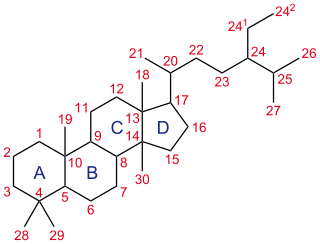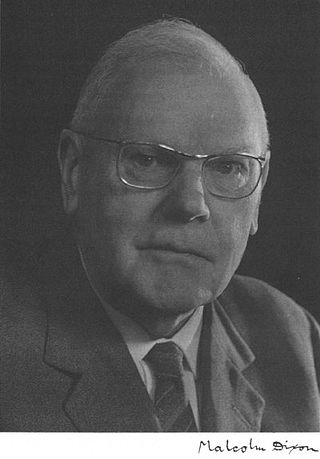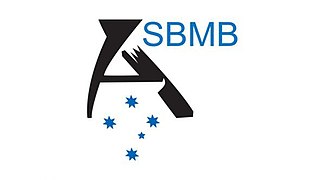
Cytochromes are redox-active proteins containing a heme, with a central iron (Fe) atom at its core, as a cofactor. They are involved in the electron transport chain and redox catalysis. They are classified according to the type of heme and its mode of binding. Four varieties are recognized by the International Union of Biochemistry and Molecular Biology (IUBMB), cytochromes a, cytochromes b, cytochromes c and cytochrome d.

The International Union of Pure and Applied Chemistry is an international federation of National Adhering Organizations working for the advancement of the chemical sciences, especially by developing nomenclature and terminology. It is a member of the International Science Council (ISC). IUPAC is registered in Zürich, Switzerland, and the administrative office, known as the "IUPAC Secretariat", is in Research Triangle Park, North Carolina, United States. IUPAC's executive director heads this administrative office, currently Greta Heydenrych.

Selenocysteine is the 21st proteinogenic amino acid. Selenoproteins contain selenocysteine residues. Selenocysteine is an analogue of the more common cysteine with selenium in place of the sulfur.

Aspartic acid, is an α-amino acid that is used in the biosynthesis of proteins. The L-isomer of aspartic acid is one of the 22 proteinogenic amino acids, i.e., the building blocks of proteins. D-aspartic acid is one of two D-amino acids commonly found in mammals. Apart from a few rare exceptions, D-aspartic acid is not used for protein synthesis but is incorporated into some peptides and plays a role as a neurotransmitter/neuromodulator.

A steroid is an organic compound with four fused rings arranged in a specific molecular configuration.
The enzyme unit, or international unit for enzyme is a unit of enzyme's catalytic activity.

In biochemistry, a transferase is any one of a class of enzymes that catalyse the transfer of specific functional groups from one molecule to another. They are involved in hundreds of different biochemical pathways throughout biology, and are integral to some of life's most important processes.

The Federation of the European Biochemical Societies (FEBS) is an international scientific society promoting activities in biochemistry, molecular biology and related research areas in Europe and neighbouring regions. It was founded in 1964 and includes over 35,000 members across 39 Constituent Societies.
The Biochemical Society is a learned society in the United Kingdom in the field of biochemistry, including all the cellular and molecular biosciences. It was founded in 1911 and acquired the existing Biochemical Journal the following year. The society additionally publishes the journals Clinical Science and Biochemical Society Transactions via its publishing arm, Portland Press. It awards the Colworth Medal and formerly awarded the CIBA Medal. As of 2024, the president is Julia Goodfellow.

Marianne Grunberg-Manago was a Soviet-born French biochemist. Her work helped make possible key discoveries about the nature of the genetic code. Grunberg-Manago was the first woman to lead the International Union of Biochemistry and the 400-year-old French Academy of Sciences.

Malcolm Dixon was a British biochemist.
William Joseph Whelan FRS was a British-born American biochemist. He was professor and chair of biochemistry and molecular biology at the Miller School of Medicine at the University of Miami. He founded the annual Miami Winter Symposium in 1967 and was chief editor of the journal IUBMB Life.
Anthony William Linnane (1930–2017) was an Australian professor of biochemistry, known for his work on mitochondria.
Maciej Żylicz is a Polish biochemist and molecular biologist, professor at the University of Gdańsk, director of the Foundation for Polish Science, member of the Polish Academy of Sciences, State Committee for Scientific Research and a corresponding member of the Polish Academy of Learning.

Athel Cornish-Bowden is a British biochemist known for his numerous textbooks, particularly those on enzyme kinetics and his work on metabolic control analysis.

Ali Akbar Moosavi-Movahedi is an Iranian biophysicist, and biophysical chemist at the Institute of Biochemistry and Biophysics, University of Tehran. He is the founder of the Iran Society of Biophysical Chemistry. He is the fellow of The World Academy of Sciences (TWAS), fellow of Islamic World Academy of Sciences (IAS), and a member of the Islamic Republic of Iran Academy of Sciences.

The Australian Society for Biochemistry and Molecular Biology (ASBMB) is an academic society founded in 1955. Originally named Australian Biochemical Society, it was renamed to its current title in 1990. Its main activities include hosting scientific conferences, supporting ancillary symposia, workshops and publishing an educational magazine.

Edwin Clifford Webb was a British biochemist.
The Korean Society for Biochemistry and Molecular Biology is a scholarly association of Korean biochemists and molecular biologists with approximately 15,000 members. It is a member of the Federation of Asia and Oceania Biochemists and Molecular Biologists (FAOBMB), International Union of Biochemistry and Molecular Biology (IUBMB), Korean Federation of Science and Technology Societies (KOFST), and Korean Academy of Medical Sciences (KAMS).













